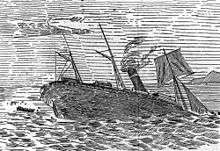RMS Quetta
 RMS Quetta in 1884 near Gravesend on the River Thames | |
| History | |
|---|---|
| Owner: | British-India SN Co |
| Operator: | British-India SN Co |
| Launched: | March 1881 |
| Fate: | Wrecked 28 February 1890 after hitting rocks near the Torres Straits. 134 people lost their lives in (at the time) what was considered Queensland's worst maritime incident. |
| General characteristics | |
| Displacement: | 3,300 tons (gross) |
| Length: | 380 ft (120 m) |
| Beam: | 40 ft (12 m) |
| Propulsion: | steam & sail |
| Speed: | Over 13 knots (24 km/h) |
| Capacity: |
|
RMS Quetta was a Royal Mail Ship that was wrecked on the Far North Queensland coast on 28 February 1890. Quetta's sinking killed 134 of the 292 people on board, and so this resulted in one of Queensland's biggest maritime catastrophes.
Background
RMS Quetta was a British-India Steam Navigation Company liner that travelled between England, India and the Far East. The Queensland Government negotiated to have a service between the United Kingdom and Brisbane, to ease the passage of people and mail. Quetta was specifically built for the Australia run, with refrigeration capacity for the frozen meat trade. The ship was launched in March 1881 and made her first voyage to Brisbane in 1883. The designation RMS indicated the ship's role within the Queensland Royal Mail Line. Her sister ships were Manora and Merkara.
The ship was initially designed for 72 saloon (first class) and 32 steerage (second class) passengers, although this was later altered to favour steerage class due to the large number of migrants using the service. In five-and-a-half years service Quetta made 11 London-Brisbane round trips; the twelfth would be her final attempt.
Disaster

On the night of 28 February 1890 the ship's master was Captain Sanders, with Captain Keatinge aboard piloting the ship through the Torres Strait. Destined for Thursday Island, the ship turned into the Adolphus Channel to round the Cape York Peninsula. The pilot was experienced, the weather fine and visibility good, but at 9:14pm the ship struck an uncharted rock in the middle of the channel near Albany Island.[1]
The rock ripped a hole through the plates from the bow to the engine room amidships, four to 12 feet wide, sinking Quetta in 5 minutes and sending 134 of her passengers to their deaths. At the time, the Quetta's loss was thought to be the worst maritime disaster of Queensland.
At the time of the disaster Quetta had 292 people aboard: a crew of 121, comprising 15 European officers, 14 from other trades and 92 lascars from India; 70 Javanese in temporary deck houses, travelling to Batavia after working in the cane fields; and 101 other passengers.
| People aboard at time of the disaster | ||
|---|---|---|
| Group | No. aboard | Survival rate |
| Javanese passengers | 70 | 79% |
| Lascar crew | 92 | 78% |
| Saloon passengers | 26 | 19% |
| Steerage passengers | 75 | 86% |
| European officers | 15 | |
| Crew (other trades) | 14 | |
| Total | 292 | 54% |
The ship's cutter floated clear of the wreck and capsized, surrounded by a large group of Javanese and lascar seamen. Quartermaster James Oates organised the baling of the cutter and it headed towards shore. Only one of the ship's lifeboats survived: Number 1 starboard lifeboat controlled by third officer Thomas Babb. It was damaged and largely awash. As it headed toward shore it picked up more survivors including Captain Sanders. Around midnight the two boats came together and those aboard were placed on the nearest island. Captain Sanders then ordered the cutter to search for more survivors.
After spending a night and day without food and water on Little Adolphus Island the main group of ninety-eight survivors were rescued by the Albatross, that along with the Merrie England had been dispatched from Thursday Island's Port Kennedy.
The Albatross took soundings and located the rock thought responsible for the disaster, about half a mile from where Quetta lay. Relics raised during salvage attempts months after the disaster, and later, can be found in the Quetta Memorial Church on Thursday Island, which was consecrated in 1893.
She now lies on her port side in 18 metres (59 ft) of water and is a protected historic shipwreck under Australia's Historic Shipwrecks Act 1976.
Memorials
As a memorial to the lives lost on the Quetta, the Quetta Memorial Precinct was established on Thursday Island, comprising a church (later a cathedral), a rectory and a church hall.[2]
Notable passengers
- Claudius Buchanan Whish and wife Anne died in the shipwreck [3]
References
- ↑ 'Quetta' wreck as reported in The Queenslander, 15 March 1890, job for post office, 3 March 1981 chart traced by Reverend A A Maclaren including Australia, Albany Island, Mount Adolphus Islands and Acoineh Island;http://trove.nla.gov.au/work/36076160
- ↑ "Quetta Memorial Precinct (entry 602168)". Queensland Heritage Register. Queensland Heritage Council. Retrieved 19 January 2014.
- ↑ Bolton, G. C. "Biography - Claudius Buchanan Whish". Australian Dictionary of Biography. Retrieved 2 October 2012.
- Underwater picture propeller and rudder
- Jeffreys, Max (1999). Murder, Mayhem Fire and Storm: Australian Shipwrecks. New Holland Publishers (Australia). pp. 163–175. ISBN 1-86436-445-9.
Further reading
- Hofer, Hubert (2004). The Wreck of the SS QUETTA.
- "A Maritime History of Torres Strait". Sportdiving in Australia & New Zealand (43). 1994.
External links
- Synge, Frances M. "Chapter VII. The Wreck of the S.S. Quetta". Albert Maclaren: Pioneer Missionary in New Guinea.
- RMS Quetta: 126th anniversary album on Flickr, by State Library of Queensland